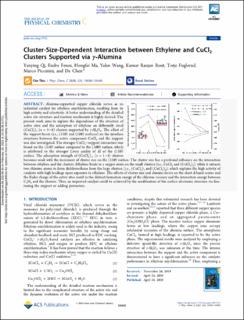| dc.contributor.author | Qi, Yanying | |
| dc.contributor.author | Fenes, Endre | |
| dc.contributor.author | Ma, Hongfei | |
| dc.contributor.author | Wang, Yalan | |
| dc.contributor.author | Rout, Kumar Ranjan | |
| dc.contributor.author | Fuglerud, Terje | |
| dc.contributor.author | Marco, Piccinini | |
| dc.contributor.author | Chen, De | |
| dc.date.accessioned | 2022-05-09T06:55:15Z | |
| dc.date.available | 2022-05-09T06:55:15Z | |
| dc.date.created | 2020-11-10T21:52:36Z | |
| dc.date.issued | 2020 | |
| dc.identifier.citation | Journal of Physical Chemistry C. 2020, 124 10430-10440. | en_US |
| dc.identifier.issn | 1932-7447 | |
| dc.identifier.uri | https://hdl.handle.net/11250/2994649 | |
| dc.description.abstract | Alumina-supported copper chloride serves as an industrial catalyst for ethylene oxychlorination, resulting from its high activity and selectivity. A better understanding of the detailed active site structure and reaction mechanism is highly desired. The present work aims to explore the dependence of the structure of active sites and the adsorption of ethylene on differently sized (CuCl2)n (n = 1–4) clusters supported by γ-Al2O3. The effect of the support facets (i.e., (110) and (100) surfaces) on the interface structures between the active component CuCl2 and the support was also investigated. The stronger CuCl2–support interaction was found on the (110) surface compared to the (100) surface, which is attributed to the stronger Lewis acidity of Al of the (110) surface. The adsorption strength of (CuCl2)n) (n = 1–4) clusters becomes weak with the increment of cluster size on the (110) surface. The cluster size has a profound influence on the interaction between ethylene and the clusters. Ethylene binds to a copper atom on the small clusters (i.e., CuCl2 and (CuCl2)2), while it extracts two chlorine atoms to form dichloroethane from the large clusters (i.e., (CuCl2)3 and (CuCl2)4), which explains the high activity of catalysts with high loadings upon exposure to ethylene. The effects of cluster size and alumina facets on the short d-band center and the Bader charge of the active sites result in the distinct formation energy of the chlorine vacancy and the interaction energy between C2H4 and the clusters. Thus, an improved catalyst could be achieved by the modification of the surface electronic structure via fine-tuning the support or adding promoters. | en_US |
| dc.language.iso | eng | en_US |
| dc.publisher | ACS Publications | en_US |
| dc.rights | Navngivelse 4.0 Internasjonal | * |
| dc.rights.uri | http://creativecommons.org/licenses/by/4.0/deed.no | * |
| dc.subject | Chlorine | en_US |
| dc.subject | Energy | en_US |
| dc.subject | Metal clusters | en_US |
| dc.subject | Hydrocarbons | en_US |
| dc.subject | Adsorption | en_US |
| dc.title | Cluster-size-dependent interaction between ethylene and CuCl2 clusters supported via γ-alumina | en_US |
| dc.type | Peer reviewed | en_US |
| dc.type | Journal article | en_US |
| dc.description.version | publishedVersion | en_US |
| dc.rights.holder | © 2020 American Chemical Society | en_US |
| dc.source.pagenumber | 10430-10440 | en_US |
| dc.source.volume | 124 | en_US |
| dc.source.journal | Journal of Physical Chemistry C | en_US |
| dc.identifier.doi | 10.1021/acs.jpcc.9b11037 | |
| dc.identifier.cristin | 1846737 | |
| dc.relation.project | Norges forskningsråd: 237922 | en_US |
| cristin.ispublished | true | |
| cristin.fulltext | postprint | |
| cristin.fulltext | original | |
| cristin.qualitycode | 1 | |

